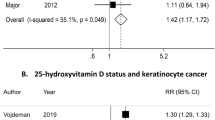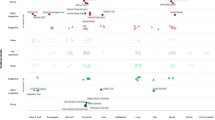Abstract
Background/Objective:
Experimental studies suggest that dietary factors may influence skin cancer risk, but there have been few human studies of diet and basal cell carcinoma (BCC), the most common type of skin cancer. The objective was to prospectively investigate the association between food intake and incidence of BCC skin cancers.
Subjects/Methods:
At baseline in 1992, 1056 adults in a subtropical Australian community completed a validated food-frequency questionnaire from which we estimated the intake of 15 food groups, selected based on hypothesized associations in the literature. Between 1992 and 2002, incident, histologically confirmed BCCs were recorded in terms of number of persons newly affected by BCC, as well as BCC tumor counts.
Results:
Intakes of the food groups were not associated with the incidence of persons affected by BCC. However, there was a borderline positive association between intake of eggs and incidence of BCC tumors (highest vs lowest tertile adjusted relative risk (RR) 1.5; 95% confidence interval (CI): 1.0–2.2; P for trend=0.06). A borderline inverse association with potato intake (highest vs lowest tertile RR 0.7; 95% CI: 0.4–1.0, P for trend=0.06) disappeared after exclusion of three subjects with more than 10 BCCs.
Conclusion:
Despite some suggestive evidence that egg and potato consumption may be associated with BCC tumor incidence, there are no plausible grounds for considering these as truly causal rather than chance associations. This study provides little evidence for a role of food intake in BCC prevention.
This is a preview of subscription content, access via your institution
Access options
Subscribe to this journal
Receive 12 print issues and online access
$259.00 per year
only $21.58 per issue
Buy this article
- Purchase on Springer Link
- Instant access to full article PDF
Prices may be subject to local taxes which are calculated during checkout
Similar content being viewed by others
References
Bialy TL, Rothe MJ, Grant-Kels JM (2002). Dietary factors in the prevention and treatment of nonmelanoma skin cancer and melanoma. Dermatol Surg 28, 1143–1152.
Black HS, Thornby JI, Wolf Jr JE, Goldberg LH, Herd JA, Rosen T et al. (1995). Evidence that a low-fat diet reduces the occurrence of non-melanoma skin cancer. Int J Cancer 62, 165–169.
Black HS, Rhodes LE (2006). The potential of omega-3 fatty acids in the prevention of non-melanoma skin cancer. Cancer Detect Prev 30, 224–232.
Christenson LJ, Borrowman TA, Vachon CM, Tollefson MM, Otley CC, Weaver AL et al. (2005). Incidence of basal cell and squamous cell carcinomas in a population younger than 40 years. JAMA 294, 681–690.
de Vries E, Louwman M, Bastiaens M, de Gruijl F, Coebergh JW (2004). Rapid and continuous increases in incidence rates of basal cell carcinoma in the southeast Netherlands since 1973. J Invest Dermatol 123, 634–638.
Diepgen TL, Mahler V (2002). The epidemiology of skin cancer. Br J Dermatol 146 (Suppl 61), 1–6.
Gardner W, Mulvey EP, Shaw EC (1995). Regression analyses of counts and rates: Poisson, overdispersed Poisson, and negative binomial models. Psychol Bull 118, 392–404.
Green A, Battistutta D, Hart V, Leslie D, Marks G, Williams G et al. (1994). The Nambour Skin Cancer and Actinic Eye Disease Prevention Trial: design and baseline characteristics of participants. Control Clin Trials 15, 512–522.
Green A, Williams G, Neale R, Hart V, Leslie D, Parsons P et al. (1999). Daily sunscreen application and betacarotene supplementation in prevention of basal-cell and squamous-cell carcinomas of the skin: a randomised controlled trial. Lancet 354, 723–729.
Hakim IA, Harris RB, Weisgerber UM (2000). Tea intake and squamous cell carcinoma of the skin: influence of type of tea beverages. Cancer Epidemiol Biomarkers Prev 9, 727–731.
Heinen MM, Hughes MC, Ibiebele TI, Marks GC, Green AC, van der Pols JC (2007). Intake of antioxidant nutrients and the risk of skin cancer. Eur J Cancer 43, 2707–2716.
Huang C, Ma WY, Ryan CA, Dong Z (1997). Proteinase inhibitors I and II from potatoes specifically block UV-induced activator protein-1 activation through a pathway that is independent of extracellular signal-regulated kinases, c-Jun N-terminal kinases, and P38 kinase. Proc Natl Acad Sci USA 94, 11957–11962.
Hughes MC, van der Pols JC, Marks GC, Green AC (2006). Food intake and risk of squamous cell carcinoma of the skin in a community: the Nambour skin cancer cohort study. Int J Cancer 119, 1953–1960.
IARC Working Group on the Evaluation of Carcinogenic Risks to Humans (ed) (1992). Solar and unltraviolet radiation. IARC Monographs on the Evaluation of Carcinogenic Risks to Humans. Vol 55. IARC: Lyon.
Ibiebele TI, van der Pols JC, Hughes MC, Marks GC, Williams GM, Green AC (2007). Dietary pattern in association with squamous cell carcinoma of the skin: a prospective study. Am J Clin Nutr 85, 1401–1408.
Kune GA, Bannerman S, Field B, Watson LF, Cleland H, Merenstein D et al. (1992). Diet, alcohol, smoking, serum beta-carotene, and vitamin A in male nonmelanocytic skin cancer patients and controls. Nutr Cancer 18, 237–244.
Lee EH, Faulhaber D, Hanson KM, Ding W, Peters S, Kodali S et al. (2004). Dietary lutein reduces ultraviolet radiation-induced inflammation and immunosuppression. J Invest Dermatol 122, 510–517.
Marks GC, Hughes MC, van der Pols JC (2006). Relative validity of food intake estimates using a food frequency questionnaire is associated with sex, age, and other personal characteristics. J Nutr 136, 459–465.
McNaughton SA, Marks GC, Green AC (2005). Role of dietary factors in the development of basal cell cancer and squamous cell cancer of the skin. Cancer Epidemiol Biomarkers Prev 14, 1596–1607.
Sies H, Stahl W (2004). Nutritional protection against skin damage from sunlight. Annu Rev Nutr 24, 173–200.
Touvier M, Kesse E, Volatier JL, Clavel-Chapelon F, Boutron-Ruault MC (2006). Dietary and cancer-related behaviors of vitamin/mineral dietary supplement users in a large cohort of French women. Eur J Nutr 45, 205–214.
Valery PC, Neale R, Williams G, Pandeya N, Siller G, Green A (2004). The effect of skin examination surveys on the incidence of basal cell carcinoma in a Queensland community sample: a 10-year longitudinal study. J Investig Dermatol Symp Proc 9, 148–151.
van Dam RM, Huang Z, Giovannucci E, Rimm EB, Hunter DJ, Colditz GA et al. (2000). Diet and basal cell carcinoma of the skin in a prospective cohort of men. Am J Clin Nutr 71, 135–141.
van der Pols JC, Heinen MM, Hughes MC, Ibiebele TI, Marks GC, Green AC (2009). Serum antioxidants and skin cancer risk: an 8-year community-based follow-up study. Cancer Epidemiol Biomarkers Prev 18, 1167–1173.
Willett WC (1998). Nutritional Epidemiology, 2nd edn. Oxford University Press: New York, pp 514.
Zou G (2004). A modified poisson regression approach to prospective studies with binary data. Am J Epidemiol 159, 702–706.
Acknowledgements
This study was supported by grants from the National Health and Medical Research Council of Australia (data collection) and the World Cancer Research Fund International (data analysis).
Author information
Authors and Affiliations
Corresponding author
Ethics declarations
Competing interests
The authors declare no conflict of interest.
Appendix A
Appendix A
Food groups consumed by participants of the Nambour skin cancer study, Australia (1992)
Rights and permissions
About this article
Cite this article
van der Pols, J., Hughes, M., Ibiebele, T. et al. Food intake and risk of basal cell carcinoma in an 11-year prospective study of Australian adults. Eur J Clin Nutr 65, 39–46 (2011). https://doi.org/10.1038/ejcn.2010.229
Received:
Revised:
Accepted:
Published:
Issue Date:
DOI: https://doi.org/10.1038/ejcn.2010.229
Keywords
This article is cited by
-
Caffeine intake and risk of basal cell and squamous cell carcinomas of the skin in an 11-year prospective study
European Journal of Nutrition (2014)



